CE Project: Mechanical Behavior of Self Curing Concrete Analysis
VerifiedAdded on 2022/08/16
|11
|1695
|12
Project
AI Summary
This project report focuses on the mechanical behavior of self-curing concrete, comparing it with conventional concrete. The study investigates the use of self-curing compounds, particularly PEG4000, to enhance water retention and hydration. The project's objectives include comparing mechanical behaviors, utilizing self-curing techniques to address water scarcity, and reducing the use of materials like fly ash. The project involved research, material testing (including sieve analysis and compressive strength tests), and analysis of results. The report details the methodologies used, including the application of saturated porous lightweight aggregate (LWA) for internal curing. The project identifies and mitigates issues encountered during testing, such as inaccuracies in sieve analysis and slump cone test results. The project's key contributions involve the analysis of concrete properties and compressive strength, providing insights into the performance of self-curing concrete. The report also includes a discussion of the team's collaborative efforts and the project's overall summary.
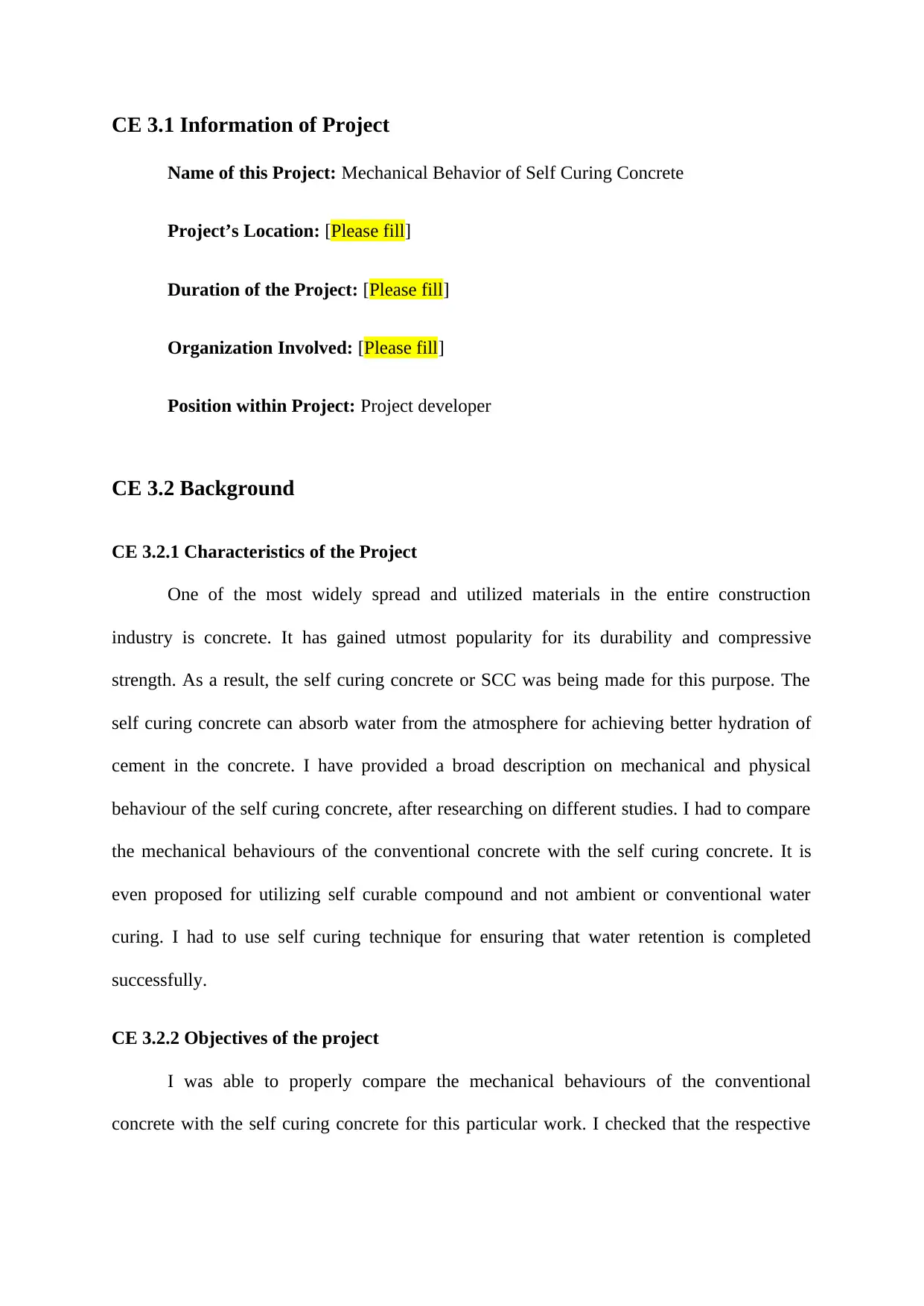
CE 3.1 Information of Project
Name of this Project: Mechanical Behavior of Self Curing Concrete
Project’s Location: [Please fill]
Duration of the Project: [Please fill]
Organization Involved: [Please fill]
Position within Project: Project developer
CE 3.2 Background
CE 3.2.1 Characteristics of the Project
One of the most widely spread and utilized materials in the entire construction
industry is concrete. It has gained utmost popularity for its durability and compressive
strength. As a result, the self curing concrete or SCC was being made for this purpose. The
self curing concrete can absorb water from the atmosphere for achieving better hydration of
cement in the concrete. I have provided a broad description on mechanical and physical
behaviour of the self curing concrete, after researching on different studies. I had to compare
the mechanical behaviours of the conventional concrete with the self curing concrete. It is
even proposed for utilizing self curable compound and not ambient or conventional water
curing. I had to use self curing technique for ensuring that water retention is completed
successfully.
CE 3.2.2 Objectives of the project
I was able to properly compare the mechanical behaviours of the conventional
concrete with the self curing concrete for this particular work. I checked that the respective
Name of this Project: Mechanical Behavior of Self Curing Concrete
Project’s Location: [Please fill]
Duration of the Project: [Please fill]
Organization Involved: [Please fill]
Position within Project: Project developer
CE 3.2 Background
CE 3.2.1 Characteristics of the Project
One of the most widely spread and utilized materials in the entire construction
industry is concrete. It has gained utmost popularity for its durability and compressive
strength. As a result, the self curing concrete or SCC was being made for this purpose. The
self curing concrete can absorb water from the atmosphere for achieving better hydration of
cement in the concrete. I have provided a broad description on mechanical and physical
behaviour of the self curing concrete, after researching on different studies. I had to compare
the mechanical behaviours of the conventional concrete with the self curing concrete. It is
even proposed for utilizing self curable compound and not ambient or conventional water
curing. I had to use self curing technique for ensuring that water retention is completed
successfully.
CE 3.2.2 Objectives of the project
I was able to properly compare the mechanical behaviours of the conventional
concrete with the self curing concrete for this particular work. I checked that the respective
Paraphrase This Document
Need a fresh take? Get an instant paraphrase of this document with our AI Paraphraser
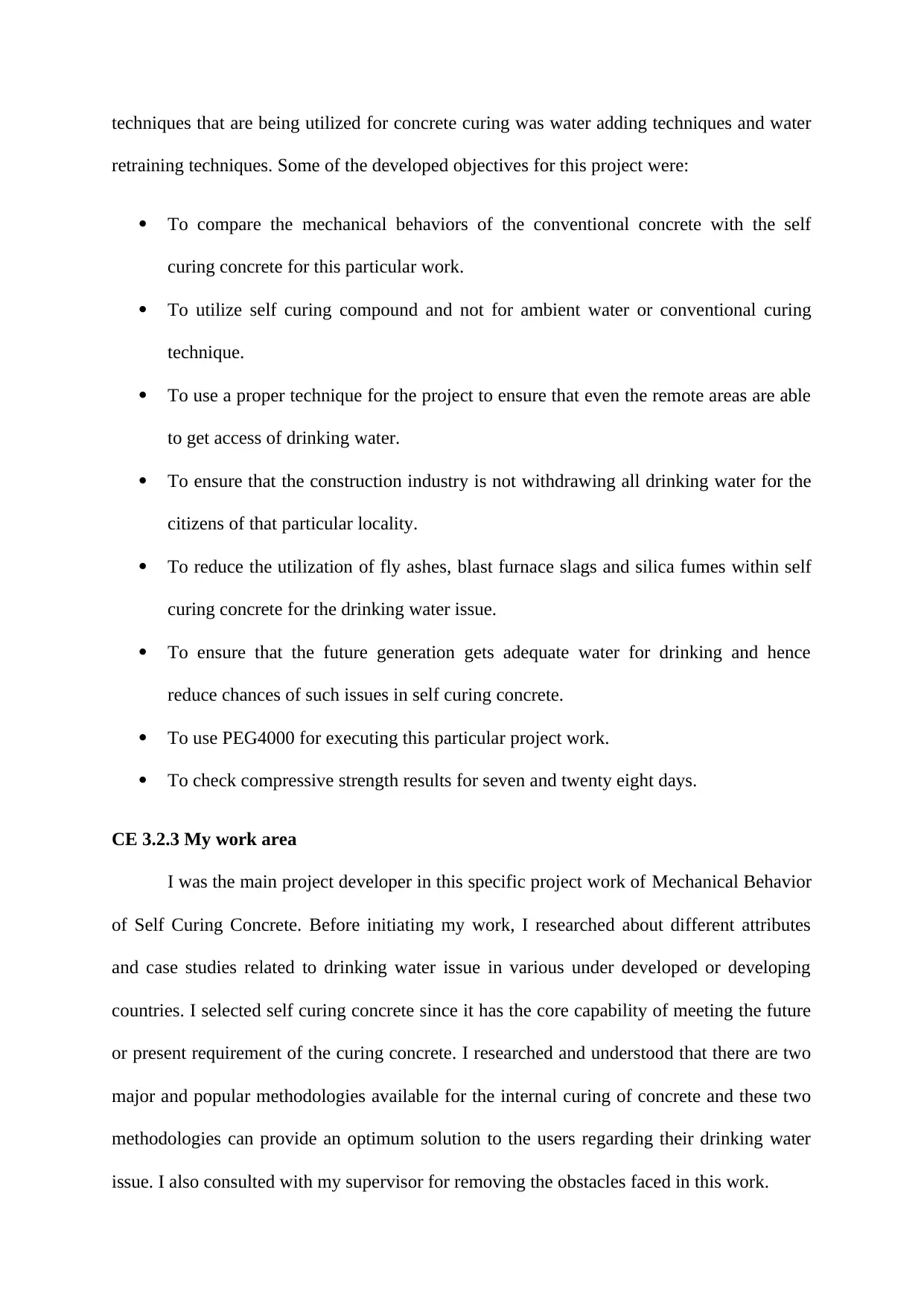
techniques that are being utilized for concrete curing was water adding techniques and water
retraining techniques. Some of the developed objectives for this project were:
To compare the mechanical behaviors of the conventional concrete with the self
curing concrete for this particular work.
To utilize self curing compound and not for ambient water or conventional curing
technique.
To use a proper technique for the project to ensure that even the remote areas are able
to get access of drinking water.
To ensure that the construction industry is not withdrawing all drinking water for the
citizens of that particular locality.
To reduce the utilization of fly ashes, blast furnace slags and silica fumes within self
curing concrete for the drinking water issue.
To ensure that the future generation gets adequate water for drinking and hence
reduce chances of such issues in self curing concrete.
To use PEG4000 for executing this particular project work.
To check compressive strength results for seven and twenty eight days.
CE 3.2.3 My work area
I was the main project developer in this specific project work of Mechanical Behavior
of Self Curing Concrete. Before initiating my work, I researched about different attributes
and case studies related to drinking water issue in various under developed or developing
countries. I selected self curing concrete since it has the core capability of meeting the future
or present requirement of the curing concrete. I researched and understood that there are two
major and popular methodologies available for the internal curing of concrete and these two
methodologies can provide an optimum solution to the users regarding their drinking water
issue. I also consulted with my supervisor for removing the obstacles faced in this work.
retraining techniques. Some of the developed objectives for this project were:
To compare the mechanical behaviors of the conventional concrete with the self
curing concrete for this particular work.
To utilize self curing compound and not for ambient water or conventional curing
technique.
To use a proper technique for the project to ensure that even the remote areas are able
to get access of drinking water.
To ensure that the construction industry is not withdrawing all drinking water for the
citizens of that particular locality.
To reduce the utilization of fly ashes, blast furnace slags and silica fumes within self
curing concrete for the drinking water issue.
To ensure that the future generation gets adequate water for drinking and hence
reduce chances of such issues in self curing concrete.
To use PEG4000 for executing this particular project work.
To check compressive strength results for seven and twenty eight days.
CE 3.2.3 My work area
I was the main project developer in this specific project work of Mechanical Behavior
of Self Curing Concrete. Before initiating my work, I researched about different attributes
and case studies related to drinking water issue in various under developed or developing
countries. I selected self curing concrete since it has the core capability of meeting the future
or present requirement of the curing concrete. I researched and understood that there are two
major and popular methodologies available for the internal curing of concrete and these two
methodologies can provide an optimum solution to the users regarding their drinking water
issue. I also consulted with my supervisor for removing the obstacles faced in this work.
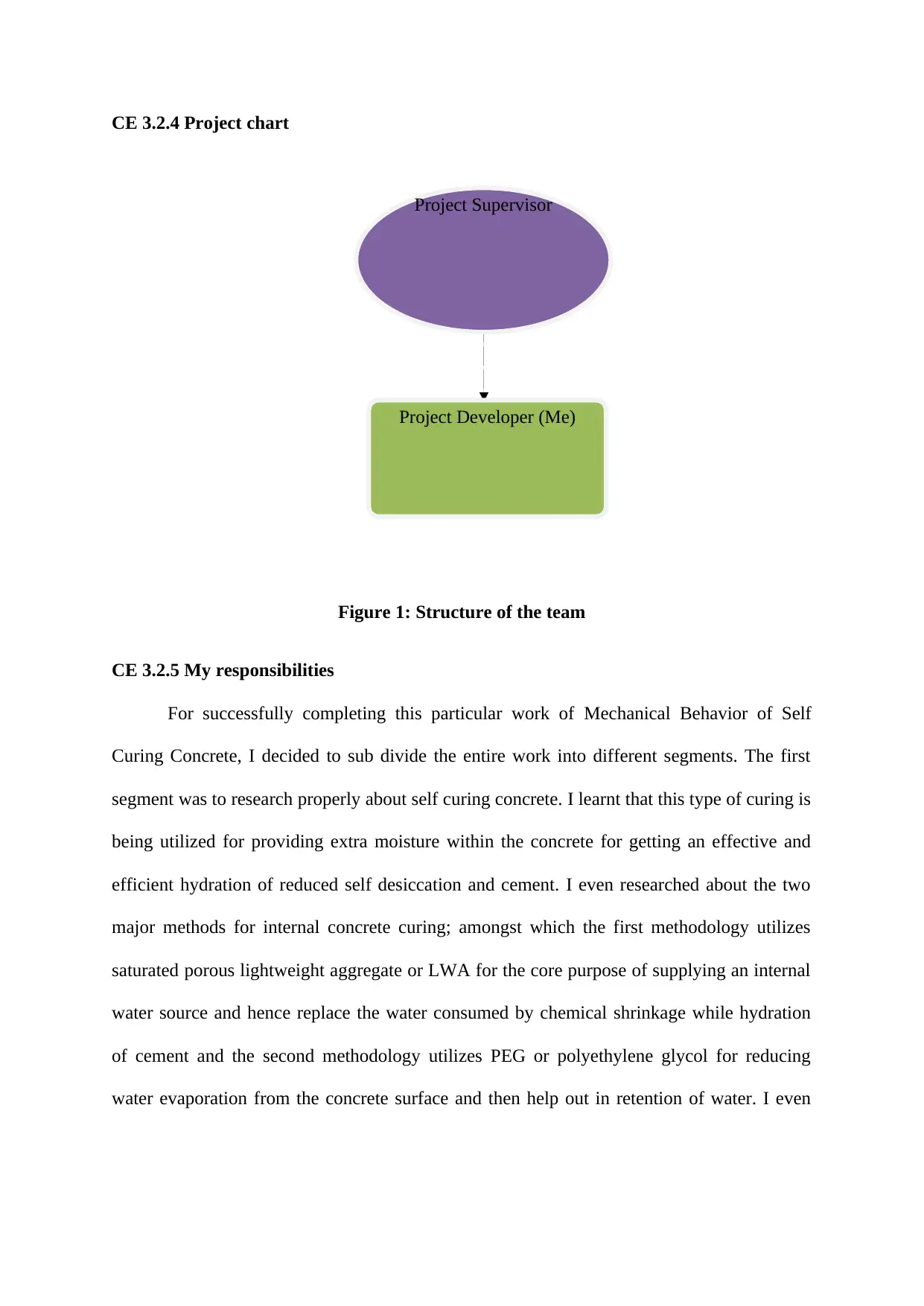
Project Supervisor
Project Developer (Me)
CE 3.2.4 Project chart
Figure 1: Structure of the team
CE 3.2.5 My responsibilities
For successfully completing this particular work of Mechanical Behavior of Self
Curing Concrete, I decided to sub divide the entire work into different segments. The first
segment was to research properly about self curing concrete. I learnt that this type of curing is
being utilized for providing extra moisture within the concrete for getting an effective and
efficient hydration of reduced self desiccation and cement. I even researched about the two
major methods for internal concrete curing; amongst which the first methodology utilizes
saturated porous lightweight aggregate or LWA for the core purpose of supplying an internal
water source and hence replace the water consumed by chemical shrinkage while hydration
of cement and the second methodology utilizes PEG or polyethylene glycol for reducing
water evaporation from the concrete surface and then help out in retention of water. I even
Project Developer (Me)
CE 3.2.4 Project chart
Figure 1: Structure of the team
CE 3.2.5 My responsibilities
For successfully completing this particular work of Mechanical Behavior of Self
Curing Concrete, I decided to sub divide the entire work into different segments. The first
segment was to research properly about self curing concrete. I learnt that this type of curing is
being utilized for providing extra moisture within the concrete for getting an effective and
efficient hydration of reduced self desiccation and cement. I even researched about the two
major methods for internal concrete curing; amongst which the first methodology utilizes
saturated porous lightweight aggregate or LWA for the core purpose of supplying an internal
water source and hence replace the water consumed by chemical shrinkage while hydration
of cement and the second methodology utilizes PEG or polyethylene glycol for reducing
water evaporation from the concrete surface and then help out in retention of water. I even
⊘ This is a preview!⊘
Do you want full access?
Subscribe today to unlock all pages.

Trusted by 1+ million students worldwide
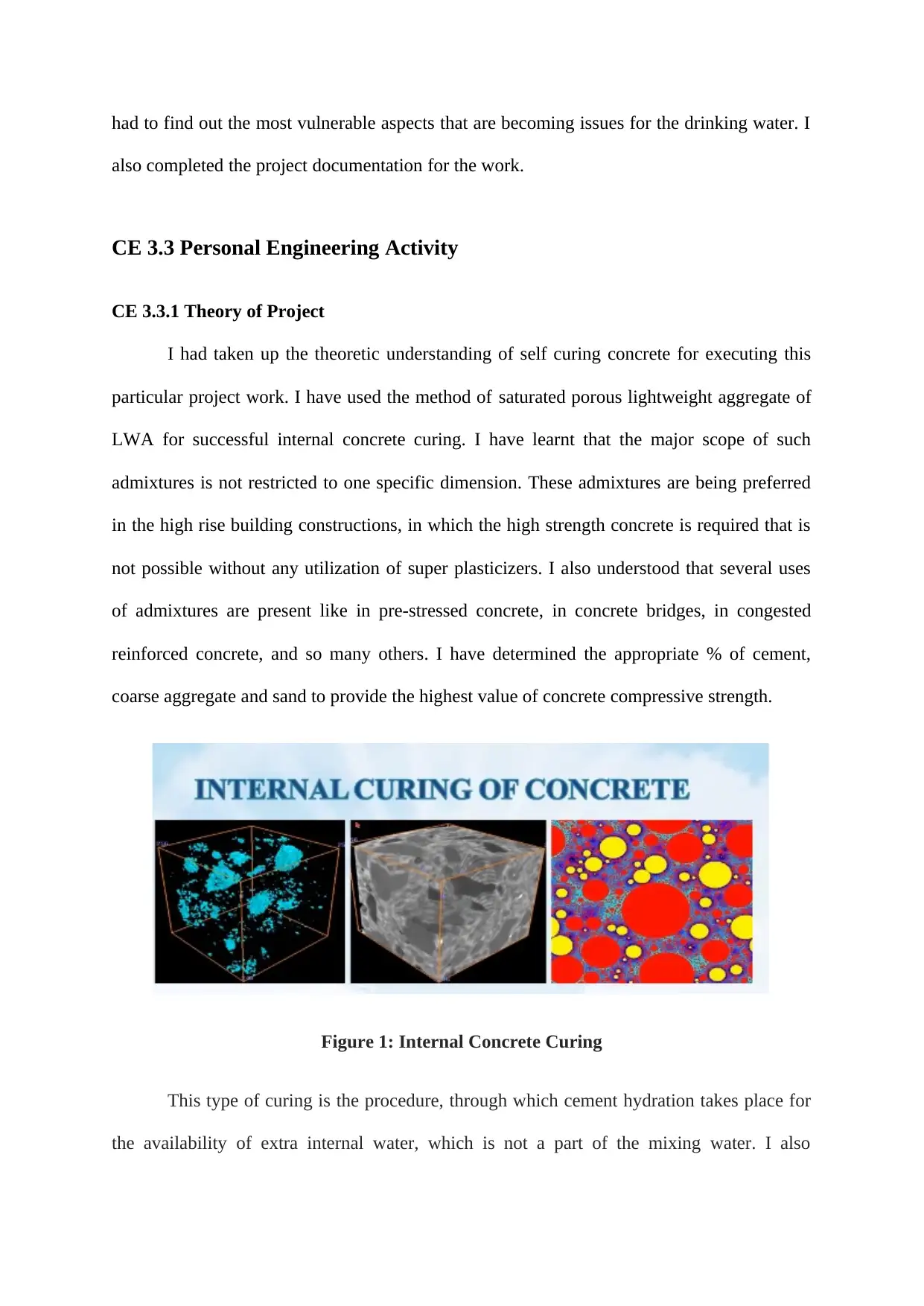
had to find out the most vulnerable aspects that are becoming issues for the drinking water. I
also completed the project documentation for the work.
CE 3.3 Personal Engineering Activity
CE 3.3.1 Theory of Project
I had taken up the theoretic understanding of self curing concrete for executing this
particular project work. I have used the method of saturated porous lightweight aggregate of
LWA for successful internal concrete curing. I have learnt that the major scope of such
admixtures is not restricted to one specific dimension. These admixtures are being preferred
in the high rise building constructions, in which the high strength concrete is required that is
not possible without any utilization of super plasticizers. I also understood that several uses
of admixtures are present like in pre-stressed concrete, in concrete bridges, in congested
reinforced concrete, and so many others. I have determined the appropriate % of cement,
coarse aggregate and sand to provide the highest value of concrete compressive strength.
Figure 1: Internal Concrete Curing
This type of curing is the procedure, through which cement hydration takes place for
the availability of extra internal water, which is not a part of the mixing water. I also
also completed the project documentation for the work.
CE 3.3 Personal Engineering Activity
CE 3.3.1 Theory of Project
I had taken up the theoretic understanding of self curing concrete for executing this
particular project work. I have used the method of saturated porous lightweight aggregate of
LWA for successful internal concrete curing. I have learnt that the major scope of such
admixtures is not restricted to one specific dimension. These admixtures are being preferred
in the high rise building constructions, in which the high strength concrete is required that is
not possible without any utilization of super plasticizers. I also understood that several uses
of admixtures are present like in pre-stressed concrete, in concrete bridges, in congested
reinforced concrete, and so many others. I have determined the appropriate % of cement,
coarse aggregate and sand to provide the highest value of concrete compressive strength.
Figure 1: Internal Concrete Curing
This type of curing is the procedure, through which cement hydration takes place for
the availability of extra internal water, which is not a part of the mixing water. I also
Paraphrase This Document
Need a fresh take? Get an instant paraphrase of this document with our AI Paraphraser
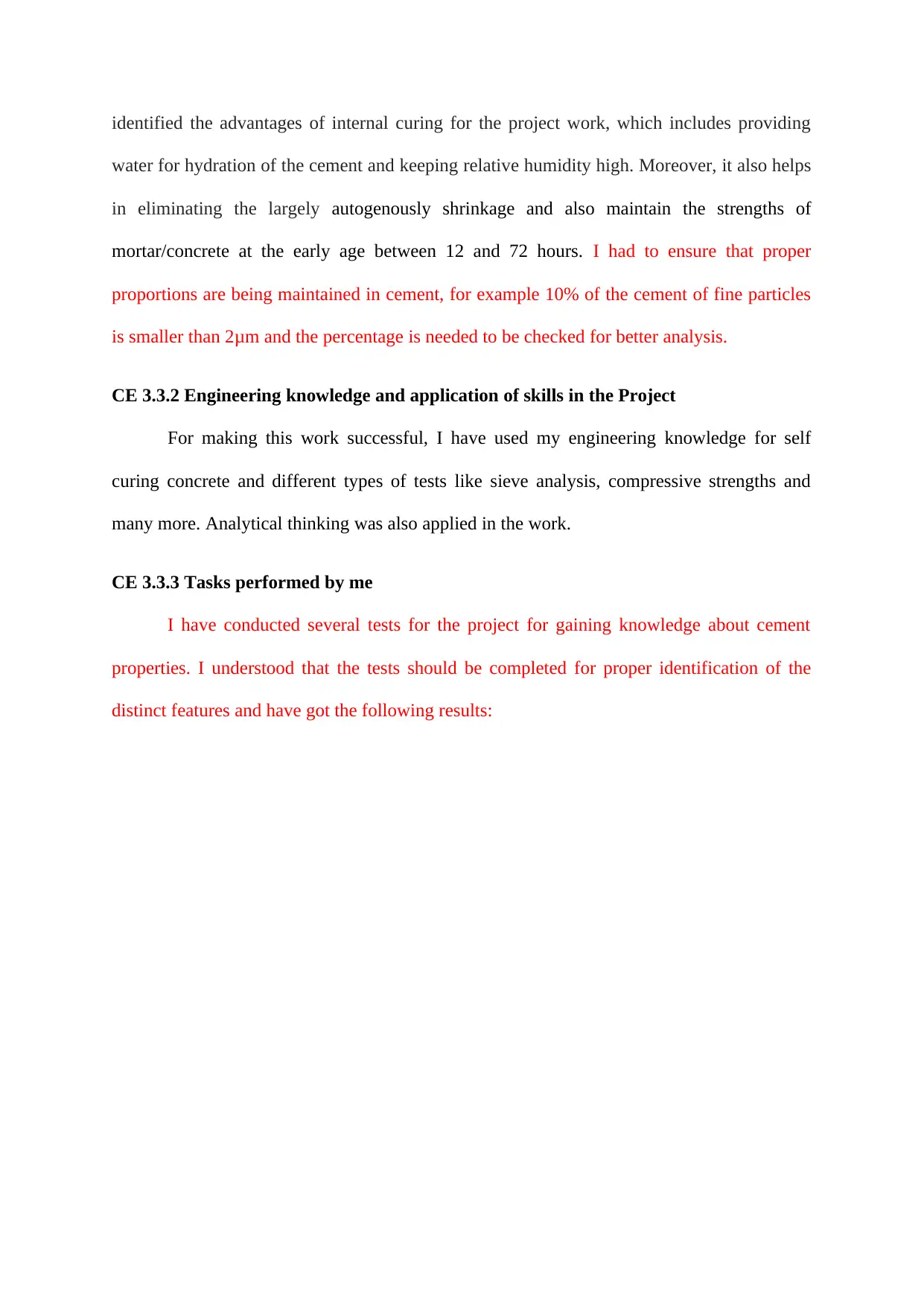
identified the advantages of internal curing for the project work, which includes providing
water for hydration of the cement and keeping relative humidity high. Moreover, it also helps
in eliminating the largely autogenously shrinkage and also maintain the strengths of
mortar/concrete at the early age between 12 and 72 hours. I had to ensure that proper
proportions are being maintained in cement, for example 10% of the cement of fine particles
is smaller than 2μm and the percentage is needed to be checked for better analysis.
CE 3.3.2 Engineering knowledge and application of skills in the Project
For making this work successful, I have used my engineering knowledge for self
curing concrete and different types of tests like sieve analysis, compressive strengths and
many more. Analytical thinking was also applied in the work.
CE 3.3.3 Tasks performed by me
I have conducted several tests for the project for gaining knowledge about cement
properties. I understood that the tests should be completed for proper identification of the
distinct features and have got the following results:
water for hydration of the cement and keeping relative humidity high. Moreover, it also helps
in eliminating the largely autogenously shrinkage and also maintain the strengths of
mortar/concrete at the early age between 12 and 72 hours. I had to ensure that proper
proportions are being maintained in cement, for example 10% of the cement of fine particles
is smaller than 2μm and the percentage is needed to be checked for better analysis.
CE 3.3.2 Engineering knowledge and application of skills in the Project
For making this work successful, I have used my engineering knowledge for self
curing concrete and different types of tests like sieve analysis, compressive strengths and
many more. Analytical thinking was also applied in the work.
CE 3.3.3 Tasks performed by me
I have conducted several tests for the project for gaining knowledge about cement
properties. I understood that the tests should be completed for proper identification of the
distinct features and have got the following results:
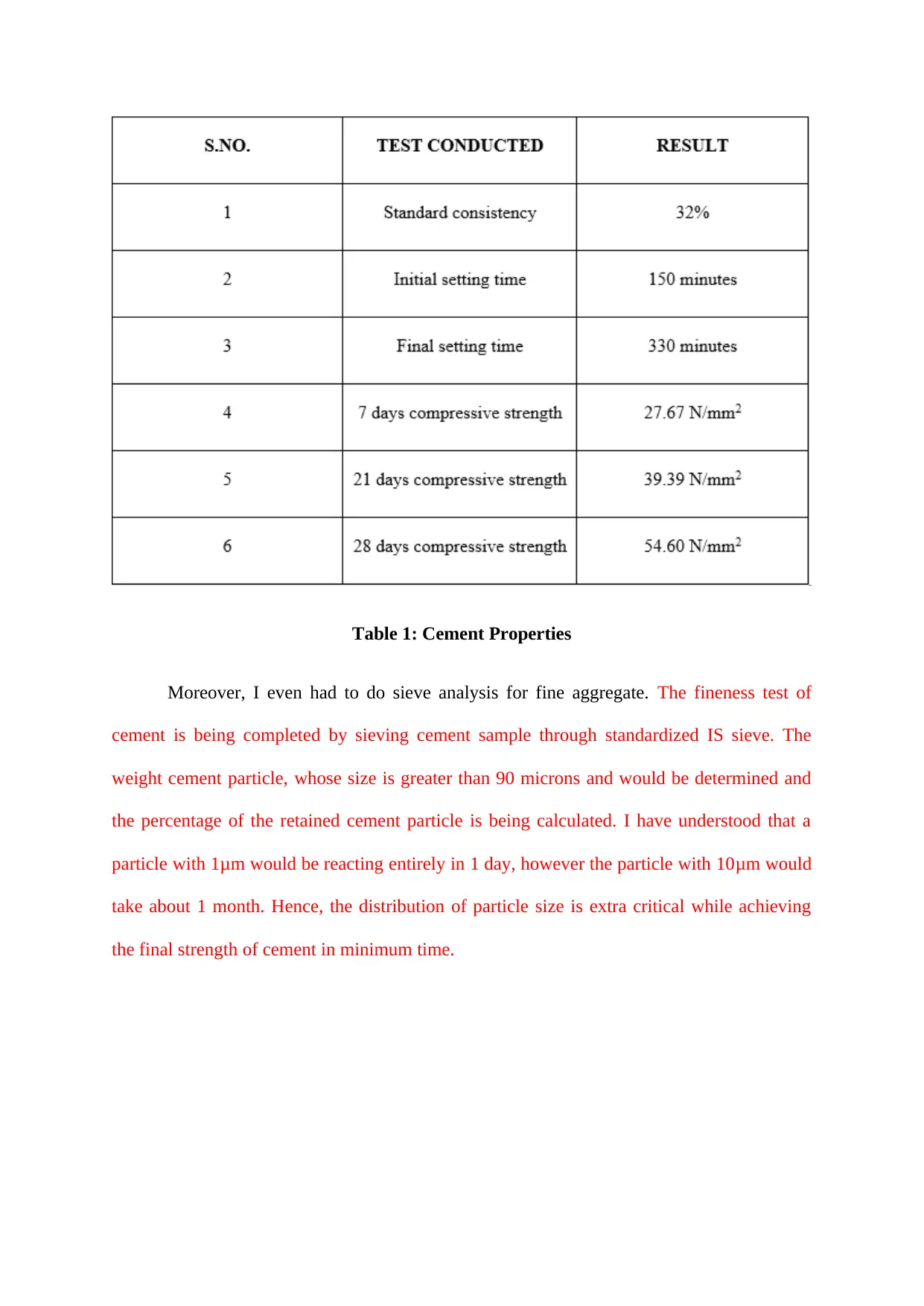
Table 1: Cement Properties
Moreover, I even had to do sieve analysis for fine aggregate. The fineness test of
cement is being completed by sieving cement sample through standardized IS sieve. The
weight cement particle, whose size is greater than 90 microns and would be determined and
the percentage of the retained cement particle is being calculated. I have understood that a
particle with 1μm would be reacting entirely in 1 day, however the particle with 10μm would
take about 1 month. Hence, the distribution of particle size is extra critical while achieving
the final strength of cement in minimum time.
Moreover, I even had to do sieve analysis for fine aggregate. The fineness test of
cement is being completed by sieving cement sample through standardized IS sieve. The
weight cement particle, whose size is greater than 90 microns and would be determined and
the percentage of the retained cement particle is being calculated. I have understood that a
particle with 1μm would be reacting entirely in 1 day, however the particle with 10μm would
take about 1 month. Hence, the distribution of particle size is extra critical while achieving
the final strength of cement in minimum time.
⊘ This is a preview!⊘
Do you want full access?
Subscribe today to unlock all pages.

Trusted by 1+ million students worldwide
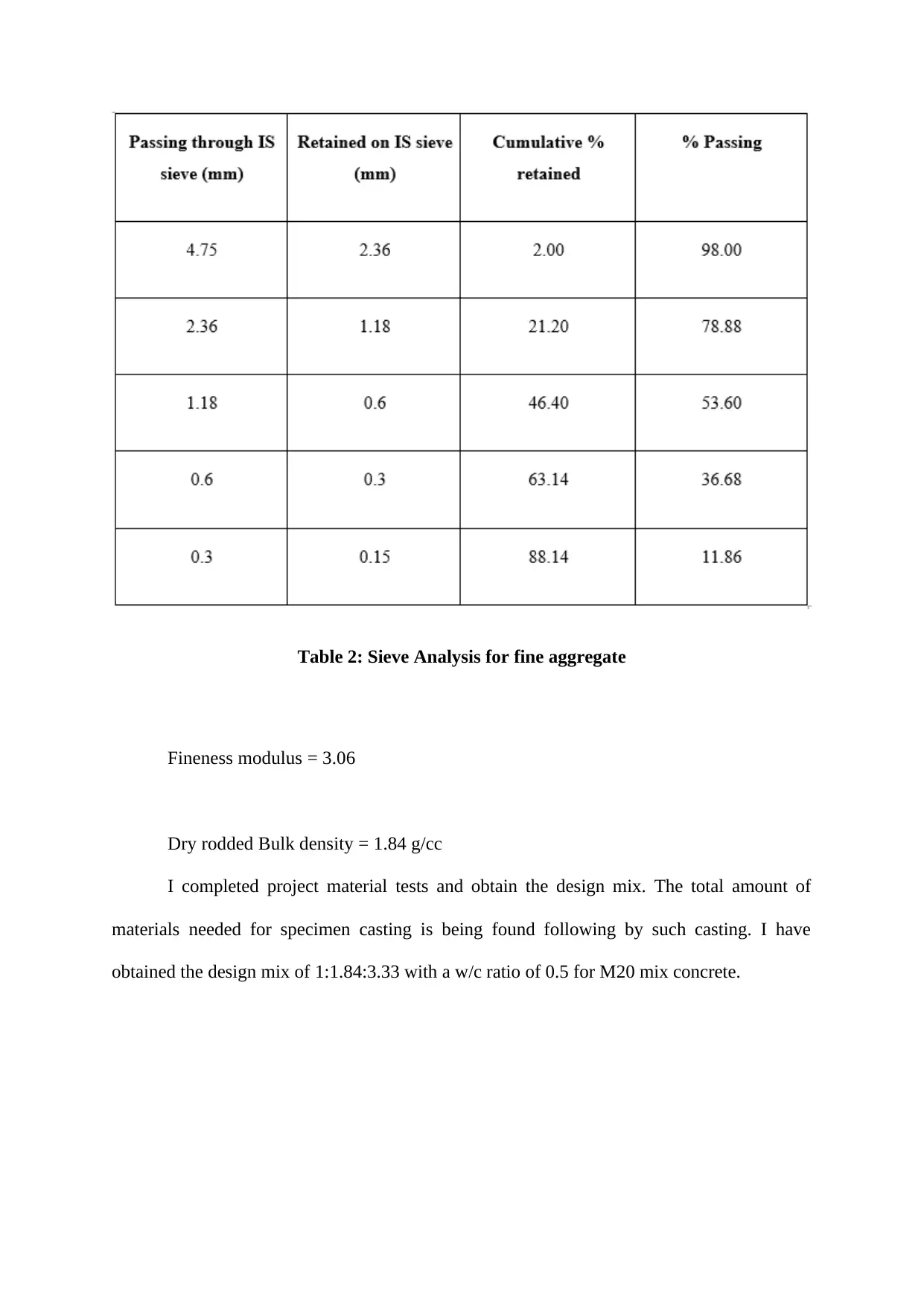
Table 2: Sieve Analysis for fine aggregate
Fineness modulus = 3.06
Dry rodded Bulk density = 1.84 g/cc
I completed project material tests and obtain the design mix. The total amount of
materials needed for specimen casting is being found following by such casting. I have
obtained the design mix of 1:1.84:3.33 with a w/c ratio of 0.5 for M20 mix concrete.
Fineness modulus = 3.06
Dry rodded Bulk density = 1.84 g/cc
I completed project material tests and obtain the design mix. The total amount of
materials needed for specimen casting is being found following by such casting. I have
obtained the design mix of 1:1.84:3.33 with a w/c ratio of 0.5 for M20 mix concrete.
Paraphrase This Document
Need a fresh take? Get an instant paraphrase of this document with our AI Paraphraser
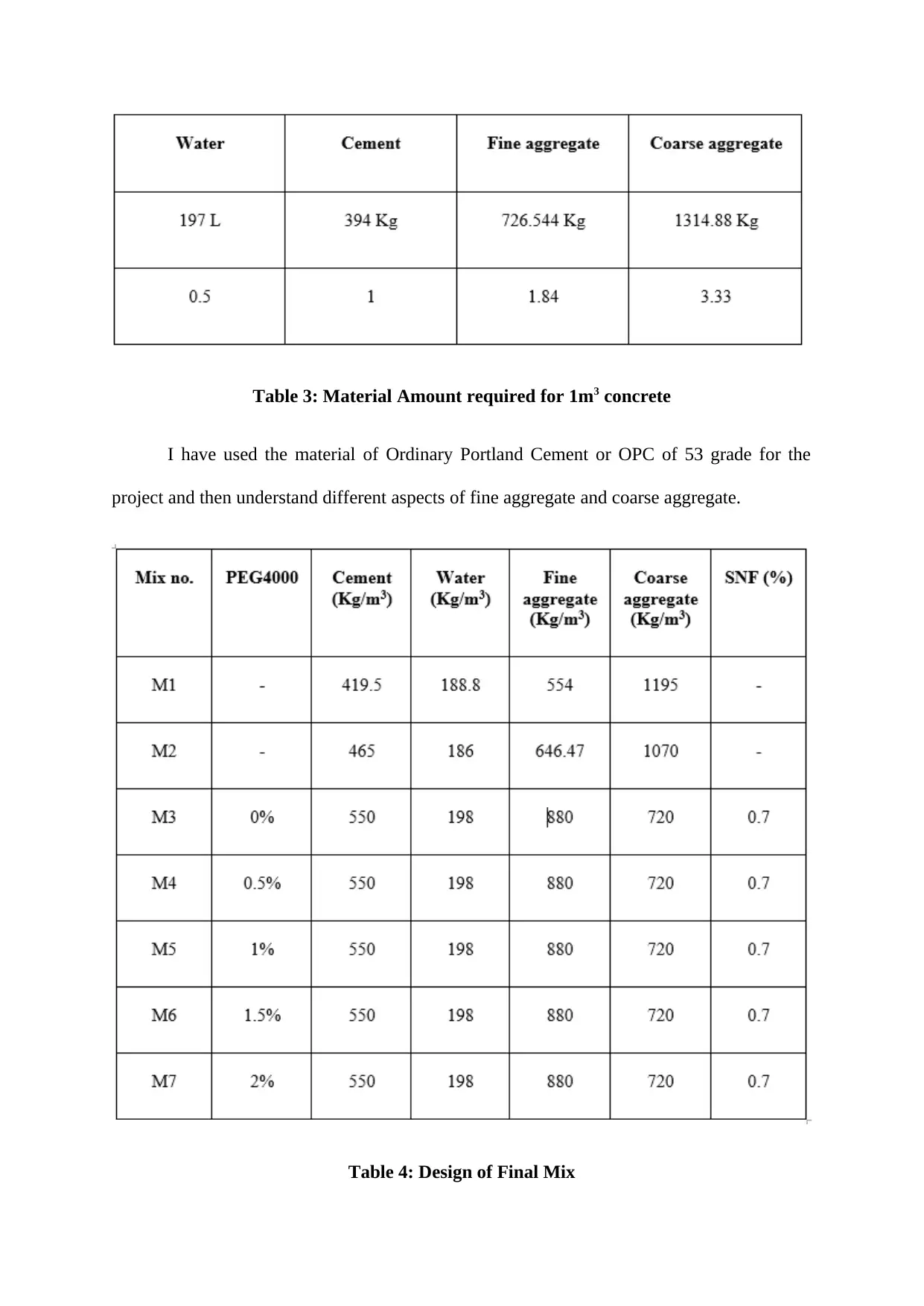
Table 3: Material Amount required for 1m3 concrete
I have used the material of Ordinary Portland Cement or OPC of 53 grade for the
project and then understand different aspects of fine aggregate and coarse aggregate.
Table 4: Design of Final Mix
I have used the material of Ordinary Portland Cement or OPC of 53 grade for the
project and then understand different aspects of fine aggregate and coarse aggregate.
Table 4: Design of Final Mix
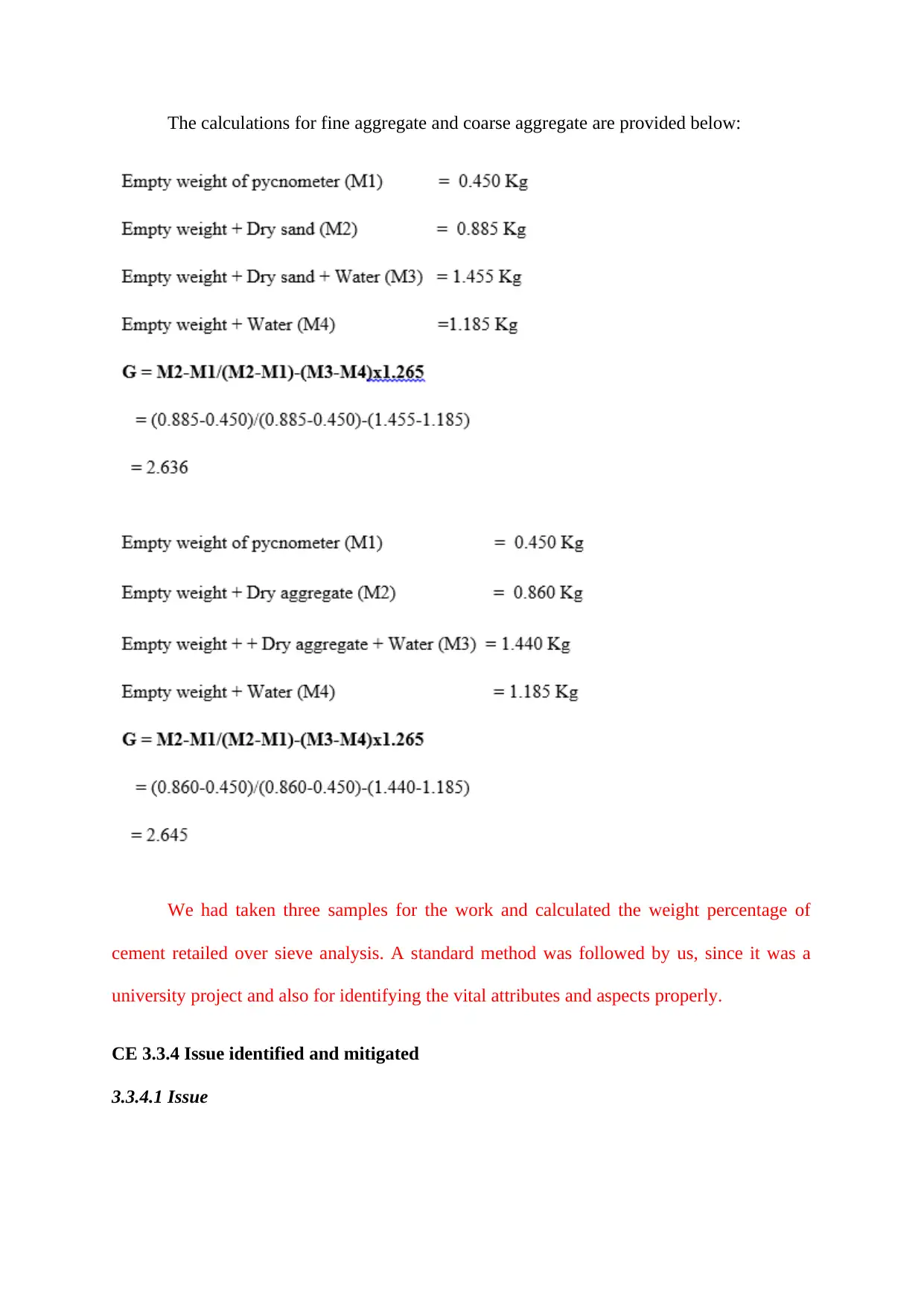
The calculations for fine aggregate and coarse aggregate are provided below:
We had taken three samples for the work and calculated the weight percentage of
cement retailed over sieve analysis. A standard method was followed by us, since it was a
university project and also for identifying the vital attributes and aspects properly.
CE 3.3.4 Issue identified and mitigated
3.3.4.1 Issue
We had taken three samples for the work and calculated the weight percentage of
cement retailed over sieve analysis. A standard method was followed by us, since it was a
university project and also for identifying the vital attributes and aspects properly.
CE 3.3.4 Issue identified and mitigated
3.3.4.1 Issue
⊘ This is a preview!⊘
Do you want full access?
Subscribe today to unlock all pages.

Trusted by 1+ million students worldwide
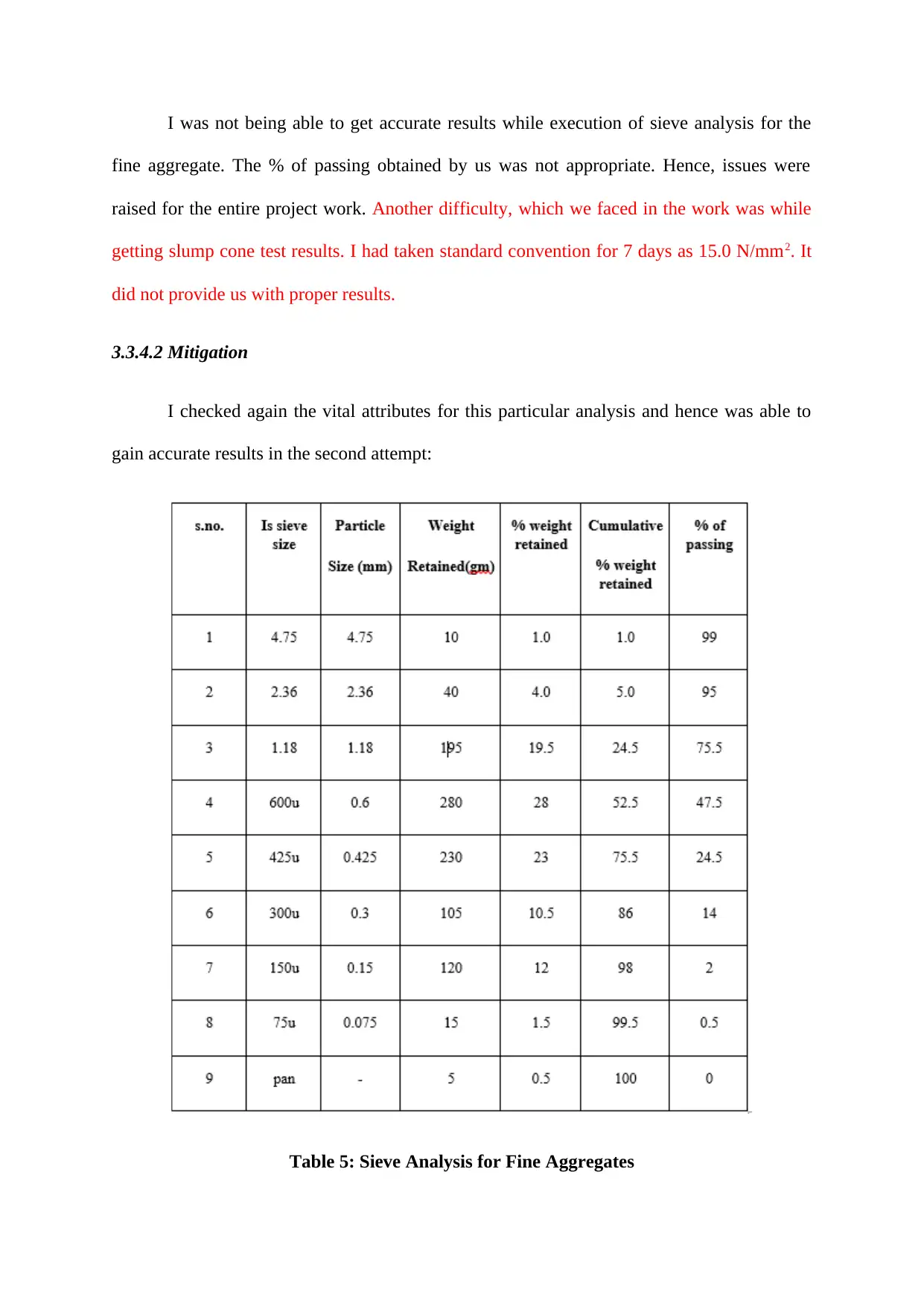
I was not being able to get accurate results while execution of sieve analysis for the
fine aggregate. The % of passing obtained by us was not appropriate. Hence, issues were
raised for the entire project work. Another difficulty, which we faced in the work was while
getting slump cone test results. I had taken standard convention for 7 days as 15.0 N/mm2. It
did not provide us with proper results.
3.3.4.2 Mitigation
I checked again the vital attributes for this particular analysis and hence was able to
gain accurate results in the second attempt:
Table 5: Sieve Analysis for Fine Aggregates
fine aggregate. The % of passing obtained by us was not appropriate. Hence, issues were
raised for the entire project work. Another difficulty, which we faced in the work was while
getting slump cone test results. I had taken standard convention for 7 days as 15.0 N/mm2. It
did not provide us with proper results.
3.3.4.2 Mitigation
I checked again the vital attributes for this particular analysis and hence was able to
gain accurate results in the second attempt:
Table 5: Sieve Analysis for Fine Aggregates
Paraphrase This Document
Need a fresh take? Get an instant paraphrase of this document with our AI Paraphraser
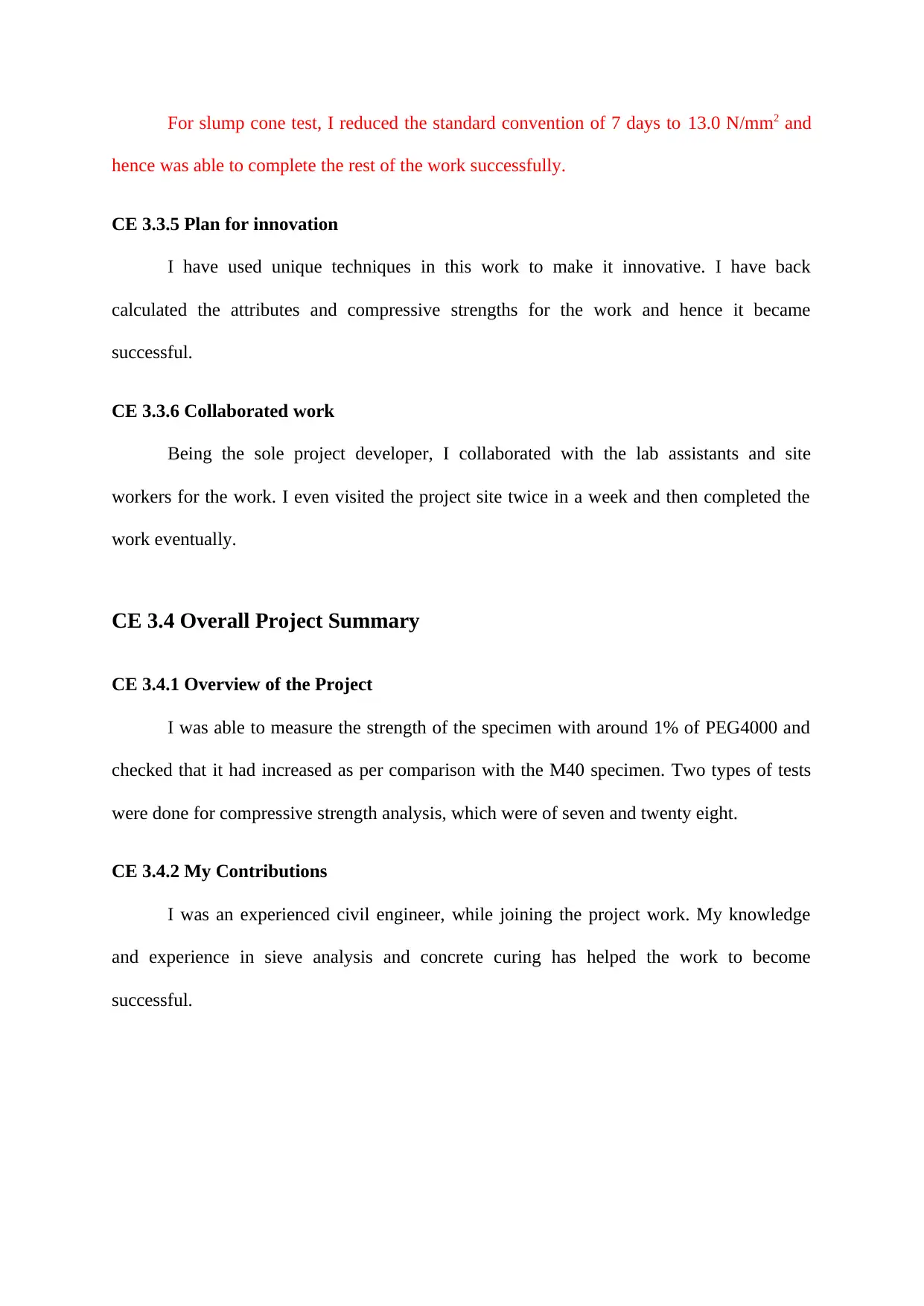
For slump cone test, I reduced the standard convention of 7 days to 13.0 N/mm2 and
hence was able to complete the rest of the work successfully.
CE 3.3.5 Plan for innovation
I have used unique techniques in this work to make it innovative. I have back
calculated the attributes and compressive strengths for the work and hence it became
successful.
CE 3.3.6 Collaborated work
Being the sole project developer, I collaborated with the lab assistants and site
workers for the work. I even visited the project site twice in a week and then completed the
work eventually.
CE 3.4 Overall Project Summary
CE 3.4.1 Overview of the Project
I was able to measure the strength of the specimen with around 1% of PEG4000 and
checked that it had increased as per comparison with the M40 specimen. Two types of tests
were done for compressive strength analysis, which were of seven and twenty eight.
CE 3.4.2 My Contributions
I was an experienced civil engineer, while joining the project work. My knowledge
and experience in sieve analysis and concrete curing has helped the work to become
successful.
hence was able to complete the rest of the work successfully.
CE 3.3.5 Plan for innovation
I have used unique techniques in this work to make it innovative. I have back
calculated the attributes and compressive strengths for the work and hence it became
successful.
CE 3.3.6 Collaborated work
Being the sole project developer, I collaborated with the lab assistants and site
workers for the work. I even visited the project site twice in a week and then completed the
work eventually.
CE 3.4 Overall Project Summary
CE 3.4.1 Overview of the Project
I was able to measure the strength of the specimen with around 1% of PEG4000 and
checked that it had increased as per comparison with the M40 specimen. Two types of tests
were done for compressive strength analysis, which were of seven and twenty eight.
CE 3.4.2 My Contributions
I was an experienced civil engineer, while joining the project work. My knowledge
and experience in sieve analysis and concrete curing has helped the work to become
successful.
1 out of 11
Related Documents
Your All-in-One AI-Powered Toolkit for Academic Success.
+13062052269
info@desklib.com
Available 24*7 on WhatsApp / Email
![[object Object]](/_next/static/media/star-bottom.7253800d.svg)
Unlock your academic potential
Copyright © 2020–2025 A2Z Services. All Rights Reserved. Developed and managed by ZUCOL.





